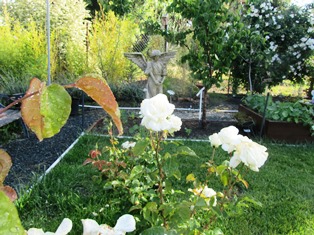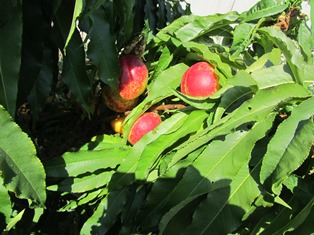Fall Spraying for Peach Leaf Curl
Just beyond the sliding glass door of my kitchen, we’ve carved a bit of a lawn and garden out of a wild weedy field. When I’m washing dishes or making jam, I can see my garden sanctuary where I’ve moved in a statue of an angel and positioned a bench near two nectarine trees–a perfect place to sit and take in the view of Mount Diablo’s peaks.
Of late, though the nectarine trees look less than healthy. The two heavy-bearers have become infected with the fungus that causes peach leaf curl. It’s not just my trees that are infected; two of my neighbors have the same problem. And this showed up late in my trees this year.
I’ve tried plucking off the twisted and contorted leaves as they show, discarding them in the garbage (not the compost pile). However, I fear I am losing this battle. The trees are going through a leaf drop now that it’s middle of November. I don’t want that fungus overwintering in the infected leaves, so I’m gathering those into the garbage, too. And I’ll begin a spraying program.
The nectarines and peaches need to be sprayed three or four times (if we have a strong rainy season), from autumn to bud break in the spring. Both lime sulfur and copper sprays can be used; both are considered organic, although some formulations are not very strong. But the leaves must not remain on the ground under the trees.
Last year, I sprayed those trees the required number of times with an organic horticultural oil recommended by the local garden center. The trees were fine most of the summer. But last month, the infection showed up. And here I am now, plucking the leaves from the trees and picking them up from the ground.
I dare not use anything on treating the fungus that is not organic and safe for the honeybees. Come spring, perhaps I’ll be rewarded for my vigilance with new growth that is healthy and free of the fungus.
Tags: copper, fungus, lime sulfur, nectarine, organic, peach leaf curl, spray
 Facebook
Facebook Goodreads
Goodreads LinkedIn
LinkedIn Meera Lester
Meera Lester Twitter
Twitter






